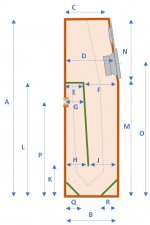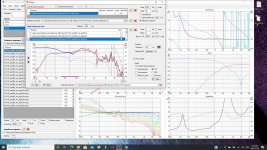Pressing Shift key while dragging inverts wire Stretch mode
Alt key returned because Shift is 'add to multi-selection' before dragging is started which might confuse.
Member
Joined 2003
^Both results are acceptable imo but of course you can continue clicking to get more accurate result. Editing of extended parameters is enabled automatically if Error is above high limit and text box is red.
Acceptable perhaps. Like I said, clicking the solve button again and again does not get to the result I can achieve above with some manual component value adjustment to nudge it in the right direction. Anyway, maybe I am over thinking, both results above create a rather similar cabinet model so seeking perfection here may just be wasting time.
both results above create a rather similar cabinet model so seeking perfection here may just be wasting time.
Exactly. Fancy impedance models can give very close to actual impedance curve, but that is not needed because final impedance curve for crossover simulation is measured anyway in final cabinet. This kind of features are for preliminary XO studies before prototype or final cabinet is not manufactured and measured. My design policy is that preliminary XO studies with pure simulation data are useless.
This is probably total off-topic, but speaker concept is not the key to good sound reproduction. Studying and building different designs, concepts, radiators, amount and type of directivity could be interesting hobby, but final solution comes with room acoustics. Shortening early delay time etc. until acoustic resolution reaches personal preference. No speaker concept is able to beat that. High quality components, construction and radiators without excessive directivity at HF to avoid spitting of artificial details.
Agree!!!
But, then again.
Creating a speaker design can include the task trying to minimize some of the effects from the room, and the speaker position. Using MathCAD and Hornresp I have an optimized design with the looks of the below picture. None of the two program results have design features for compensation of room and position. And still the design has no crossover.
So along that way of the quote. The below design has a tilted (only 2 degrees vertical listening angle) , bent baffle so the effects from the baffle are there. Also it has the port pointing to the wall about half a meter off the floor which will have a large impact depending on the position of the speaker.
So for me, with almost 50 years of experience building "others" designs but just recently stepping into the world of own designs, it would be interesting to know YOUR brightest thoughts of how to compensate for those two things:
1) The tilted and bent baffle.
2) The MLTL port pointing against the wall a half meeter from the floor.
Thanks in advance!
Attachments
Last edited:
I do not understand this.long planar/ribbon and horn requires very high quality driver to avoid spitting HF resonances to your face.
i do not understand the extended z model in the calc t/s parameter feature:
if i have two curves loaded: free air with no mass + free air with mass then the extended z model error box lights up red, but if i remove the added mass curve then i get a nice fit. but as soon i load the added mass curve then the error box turns red again, i guess i need both impedance curves to get accurate t/s calculations?
it would be nice if both 'basic z model' and the 'ext z model' where saved and the user later could easily select between basic / ext / none z model when doing box work.
also, it would be nice if it where possible to import a box impedance measurment to the simulated box impedance, in that way it would be easy to adjust box parameters to match the measured impedance curve for further box tweaking
if i have two curves loaded: free air with no mass + free air with mass then the extended z model error box lights up red, but if i remove the added mass curve then i get a nice fit. but as soon i load the added mass curve then the error box turns red again, i guess i need both impedance curves to get accurate t/s calculations?
it would be nice if both 'basic z model' and the 'ext z model' where saved and the user later could easily select between basic / ext / none z model when doing box work.
also, it would be nice if it where possible to import a box impedance measurment to the simulated box impedance, in that way it would be easy to adjust box parameters to match the measured impedance curve for further box tweaking
if i have two curves loaded: free air with no mass + free air with mass then the extended z model error box lights up red, but if i remove the added mass curve then i get a nice fit. but as soon i load the added mass curve then the error box turns red again, i guess i need both impedance curves to get accurate t/s calculations?
Calculation of extended Z model parameters alone needs free air response. Second response should not be loaded. Program does not change standard T/S, and Error text box shows error within 8 x fs ... 20 kHz where extended parameters are effective.
If you are calculating standard T/S parameters while extended Z model parameters are kinda side product, you should load two or three impedance responses. You also need to enter Sd and Re for added mass or sealed in addition to correct mass(es)/volume. Error text box shows error within 0.8 x fs ... 20 kHz so text box will be red very easily if you are not really calculating all T/S with required and correct parameters from user.
would be easy to adjust box parameters to match the measured impedance curve for further box tweaking
As mentioned few messages ago, accurate impedance response could be valuable while preliminary (inaccurate) crossover simulation. Not for box tweaking so you don't need any fancy Z parameters to design and make a box.
I do not understand this.
Very high DI or ribbon/planar might spit some HF sound of recordings and resonances of radiator to the face. It's like shooting of sound so that S,Z,... seem to locate at a half of listening distance while the rest of sound image locates close to speakers or further.
I don't agree that a narrow sound beam will attack like a laser. However it can be more challenging to cross properly when there is lobing.
Consider a full-range speaker. It will beam and vary with frequency.. but its behaviour can be explained and predicted by looking at its polars.
Consider a full-range speaker. It will beam and vary with frequency.. but its behaviour can be explained and predicted by looking at its polars.
Creating a speaker design can include the task trying to minimize some of the effects from the room, and the speaker position.
Sure. Radiator type and number of drivers might have significant influence how low frequencies work especially if some problems exist after acoustical treatment, and listener is not willing or able to optimize position of speakers and listener by LF performance so that e.g. sound stage is not the best possible while LF performance is.
But generally, hifi enthusiasts are quite deaf for LF performance other than resonance peaks. They listen sound stage, timbre and dynamics. In that scene room acoustics (short EDT) is more effective/rational, balanced and natural to increase acoustical resolution compared to directivity concepts common and possible for the most in practice. Of course we can explain that "wife acceptance factor" of room acoustics is lower than directive speakers, and therefore speakers should be directive at upper mid ... mid treble to maximize subjective impression about acoustic resolution.
Anyway, I try to avoid discussion how speakers should be designed. My opinions with some commercial limits are mostly reserved for few small companies.
I don't agree that a narrow sound beam will attack like a laser.
I don't expect that all of us have negative experiences with HF beaming. This might depend on luck, records, listening distance and possibly also age and physics of ears so I don't need or ask agreement.
However it can be more challenging to cross properly when there is lobing.
Consider a full-range speaker. It will beam and vary with frequency.. but its behaviour can be explained and predicted by looking at its polars.
I guess this relates to some other tread? I would say that lobing especially at lower...mid treble is probably significant problem if listening elevation varies and listening distance is so short that significance of direct sound is high in overall balance.
Nevertheless sound of multi-way could be better in casual listening from random position far from speaker than with coaxial or full range. Could be challenging, but possible with proper design methods and some luck with drivers before the key to the problem is found.
2.0.61.0 (2021-01-20)
Main Options
* Added Normalize SPL checkbox to Frequency responses group. SPL traces are normalized to level of frequency responses loaded for drivers with generator voltage of 2.83 V. Default value is checked, compatible with earlier versions down to 0.1. Keep checked to avoid tuning of SPL and Power targets if listening distance is changed.
Main Options
* Added Normalize SPL checkbox to Frequency responses group. SPL traces are normalized to level of frequency responses loaded for drivers with generator voltage of 2.83 V. Default value is checked, compatible with earlier versions down to 0.1. Keep checked to avoid tuning of SPL and Power targets if listening distance is changed.
I have my Automatic Arta turntable all setup and working now, just a quick question about frequency recording types.
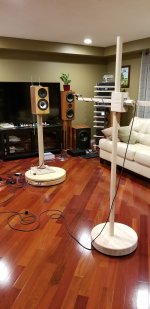
Is Sine Sweep better than Periodic Noise?
Can the two types be combined with the expected output levels the same?
i.e. Can you use Sine Sweep for woofer and Periodic Noise for tweeter?
Thank you, David.
P.S. I ended up making my own mic stand that only goes up and down in order to maintain distance between DUT and mic when measuring drivers. My speaker stand has a stop on the back of it, also to maintain distance.

Is Sine Sweep better than Periodic Noise?
Can the two types be combined with the expected output levels the same?
i.e. Can you use Sine Sweep for woofer and Periodic Noise for tweeter?
Thank you, David.
P.S. I ended up making my own mic stand that only goes up and down in order to maintain distance between DUT and mic when measuring drivers. My speaker stand has a stop on the back of it, also to maintain distance.
^All signals (White PN, Pink PN, Sweep and MLS) have the same level in ARTA.
Sine sweep has the best S/N ratio so that's recommended especially for woofers, ports and mids. You can switch to White PN for tweeter to reduce power at LF. No need for separate high pass with conventional domes.
MLS can not compensate response errors in dual channel model so it's not recommended without calibration including both mic and sound card in case response of sound card is bad.
Sine sweep has the best S/N ratio so that's recommended especially for woofers, ports and mids. You can switch to White PN for tweeter to reduce power at LF. No need for separate high pass with conventional domes.
MLS can not compensate response errors in dual channel model so it's not recommended without calibration including both mic and sound card in case response of sound card is bad.
David
P.S. I ended up making my own mic stand that only goes up and down in order to maintain distance between DUT and mic when measuring drivers. My speaker stand has a stop on the back of it, also to maintain distance.[/QUOTE]
Hi David, I know that there are Plans at the ARTA website and on the internet but I had some trouble following them for an automatic turntable, especially the sourcing of materials. Would you very much mind sharing your Plans and sourcing information?
Thanks,
Jay
P.S. I ended up making my own mic stand that only goes up and down in order to maintain distance between DUT and mic when measuring drivers. My speaker stand has a stop on the back of it, also to maintain distance.[/QUOTE]
Hi David, I know that there are Plans at the ARTA website and on the internet but I had some trouble following them for an automatic turntable, especially the sourcing of materials. Would you very much mind sharing your Plans and sourcing information?
Thanks,
Jay
Hi David, I know that there are Plans at the ARTA website and on the internet but I had some trouble following them for an automatic turntable, especially the sourcing of materials. Would you very much mind sharing your Plans and sourcing information?
Thanks,
Jay
Here are the instructions, I translated them from German to English as best I could,
View attachment ARTA-Hardware&Tools AutomaticTurntable-GerRev1.2.de.en.pdf
View attachment AP-9+ARTA-AutomaticTurntable-GerRev1.4a+(1).de.en.pdf
Here are the hard to find parts that I used,
Motor,
Pololu - 150:1 Metal Gearmotor 37Dx73L mm 12V with 64 CPR Encoder (Helical Pinion)
Motor gear,
https://www.amazon.ca/gp/product/B0087EA32Q/ref=ppx_yo_dt_b_search_asin_title?ie=UTF8&psc=1
Circuit board,
ARTA Drehteller Modul - Ingenieurburo Grafe
Geared lazy susan turntable (slewing ring),
Drehkranz Alu-Druckguss 330 mm verzinkt | Alu-Druckguss | Drehkranze | Hefter Fertigungstechnik
A couple of pics of my build,
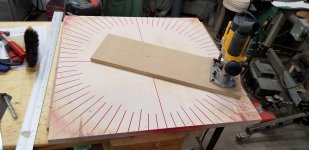
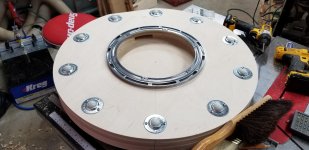
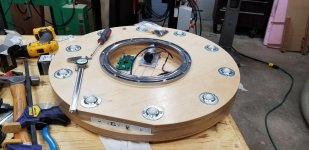
Boring as heck Video,
Arta Turntable 0 to 180 to 0 - YouTube
If you are in NA like me, expect to take a LONG time to collect everything you need and for it not to be cheap.
- Home
- Design & Build
- Software Tools
- VituixCAD
